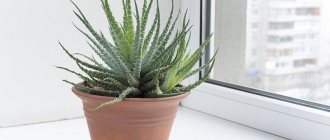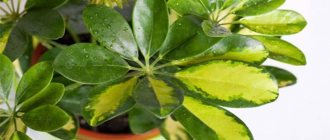Large gerbera flowers with a basket can be either double or smooth, with a core of white or dark tones. The maximum flowering period is 2 months. The lifespan of a flower is no more than 3 years.
Also look out for Jacobinia and Gloriosa plants.
| Average growth rate. |
| Blooms in autumn, summer and spring. |
| Easy to grow, but a little difficult |
| Lives 2-3 years. |
Beneficial features
Gerberas are colorful flowers with a delicate aroma that, at home, will not harm even allergy sufferers or asthmatics. This flower serves as a natural air purifier, filtering oxygen from harmful impurities. In addition, a useful property of gerbera is its ability to maintain a blooming decorative appearance for about a month.
Basic rules for caring for gerberas
Gerbera at home takes root quite quickly and does not cause much trouble if you follow the basic points of proper flower care, namely:
| Temperature | In summer, it should not exceed 21 degrees; in winter, low temperatures are desirable - up to 15 degrees Celsius. |
| Air humidity | Typical for indoor conditions is 60-65%. |
| Lighting | Bright, sunny, or supplementary lighting. |
| Watering gerberas | Regular during hot periods, after flowering - more rare, and also through the tray. |
| Priming | A loose, permeable substrate with the addition of perlite, peat, sand. |
| Feeding and fertilizer | Mineral compositions are used for ornamental flowering plants. |
| Transfer | It is carried out by transshipment every year after flowering. |
| Reproduction | It is possible by planting seeds, as well as using shoots. |
| Features of cultivation | Does not bloom in the shade, is very sensitive to temperature conditions, and susceptible to diseases. |
Acclimatization and site selection
Some novice gardeners mistakenly believe that flowering indoor plants must be placed on the sunniest windowsill, and they are mistaken. Many flowers, especially gerberas, do not like heat and direct rays of the sun. They burn the leaves and heat the roots, causing the plants to wilt.
For the first two days after purchase, a gerbera in a pot should be kept in the back of the room so that it adapts. Then place the flower on a well-lit windowsill without direct sunlight.
In spring and summer, an eastern or even northern window sill is suitable for the plant, and in autumn and winter - western and southern. If the windows face one side and the sun is simply “hot” during the day, move the pot of gerbera deep into the room at this time.
By the way! The budding of gerberas occurs when the daylight hours are more than 10 hours. That's why they bloom in spring and summer. If you want your gerberas to bloom in autumn or even winter, provide them with greenhouse conditions with more than 10 hours of daylight. To do this, special lighting lamps are installed above the plants.
The air temperature for growing indoor gerbera at home should be within +18..+22 degrees.
In summer, it is easier to provide good lighting and cool conditions, since in a sunny apartment the flower can be placed next to the window and the windows can be opened for ventilation. But what to do in winter, when the radiators under the windowsills simply fry? We recommend covering them with a damp cloth and spraying the plant regularly.
You might be interested to know: Planting and growing lemons at home from a seed
Attention! You can spray gerbera, but not on the leaves, but by splashing water around. Make sure that water does not get on the foliage and flowers, or better yet, do not spray the plants at all during flowering. To increase humidity, you can place a wide container of water nearby.
Care for gerbera at home Details
After acquisition, the plant is given the opportunity to settle in current conditions for about two weeks. Most often, purchased flowering gerbera dies after flowering, since these flowers usually get used to being kept in a greenhouse, where the necessary climate and illumination are provided for at least 12 hours a day. And immediately after purchase, a gerbera flower at home cannot always adapt to a new place, and as a result, the plant produces only foliage without inflorescences, or dies.
But you can try to save the purchased gerbera. To do this, two weeks after purchase, without even waiting for complete flowering, the plant is transplanted into a larger pot, replacing temporary store-bought soil.
Gerbera flowering
With proper care, gerberas can delight you with flowers several times a year. resembling chamomile can bloom on one plant at the same time The diameter of the flowers is quite large – 5 cm, with petals of regular, “double” or needle-shaped. The variety of shades of gerbera allows you to decorate absolutely any interior with this flower. In addition, with proper care, the plant remains fresh for at least a month.
Temperature
A very important point in caring for gerberas is maintaining temperature balance both in summer and in winter. In the first case, the flower should not be allowed to overheat, otherwise the risk increases and the flowering period will not wait at all. The maximum permissible temperature in summer is 21 degrees.
In winter, the plant is sent for a “respite”, in a cool room with a temperature no higher than 14 degrees Celsius with the possibility of regular ventilation.
Spraying
Home gerbera almost always needs spraying. In winter, this measure will help prevent the flower from drying out due to the heating systems. In the summer, moisture evaporates very quickly from the surface of the soil and from the plant itself, so spraying will help maintain the desired balance, preventing the foliage from withering and rotting, which is possible if you overdo it a little with watering.
For spraying, it is better to use a fine spray bottle. Large drops falling directly on flowers standing in the sun can lead to burn spots.
Gerbera lighting
Morning or evening soft sunlight will help gerberas feel great at any time of the year. It is better not to expose it to direct midday rays, otherwise overheating and burns will occur, which will only destroy the flower.
In cloudy, cool weather, it is recommended to organize additional illumination of gerberas. Only in this case can you count on the flower to live for more than one year.
Watering
Moderate watering is an indispensable condition for the successful development of gerbera. Even in hot weather, the plant should not be flooded, since waterlogging of the soil cover leads to rotting of the roots or the appearance of fungal diseases. Basic rules for watering this flower:
- the top layer of soil should not dry out deeper than 2-3 cm
- In winter, watering should be reduced, the rule works here - it’s better to underwater a little than to overwater
- use only settled or melted water, as well as rain water
- If after watering excess water has accumulated in the pan, it must be poured out.
Priming
Any loose, permeable soil is ideal for gerbera. For example:
- acidic azalea soil;
- high-moor peat with perlite, one part of each;
- universal soil for ornamental flowering plants with an admixture of vermiculite;
- substrate made of peat, sand and leaf soil at a ratio of 1:1:2
Regardless of the composition of the soil, a drainage layer is also created - from expanded clay, shell rock or small pebbles.
Feeding and fertilizer
For successful growth, any indoor flower needs additional microelements, including gerbera. Home care involves regular feeding of the plant, which is carried out two months after transplantation and subsequently every ten days. At the stage of foliage growth, the flower requires nitrogen-containing fertilizer. After the plant gets stronger, mineral compositions are needed for flowering plants, which will be sufficient even if you use half the recommended dose.
Transfer
Replanting indoor gerberas is most often carried out using the transshipment method, if this is not the very first procedure after the store.
Store-bought soil should be completely replaced, since it does not contain beneficial substances for the plant, but has stimulating agents to preserve the flowering appearance. So, when replanting for the first time after the store, the dried soil of the flower must be slightly moistened, carefully remove the plant, completely free the roots from the soil and disinfect them in a fungicide solution. Then they are placed in a new pot and specially prepared soil. At the next home transplant, it is enough to transfer the earthen ball with the plant to a new pot, without affecting the root system, and fill the flower bowl with the missing amount of fresh soil. An important nuance - when replanting a gerbera, its root collar is left 2-3 cm above the soil surface, in order to avoid infection with fungal pathologies.
Rest period
Gerbera flowers at home do not always bloom readily. To get regular flowering, it is necessary to give the plant rest in winter. Namely, remove wilted inflorescences and leaves, place in a cool place with a temperature of about 12 degrees, ventilate the room and maintain a moderate moisture balance in the soil. Closer to spring, the flower is placed in a warm sunny place; if necessary, you can arrange a mini-greenhouse.
Gerbera transplant
The bright life span of indoor gerberas is short, only 3–4 years. Then the bushes lose their decorative properties and bloom less frequently and sparingly. Through reproduction, young specimens are grown, and old ones are thrown away. Therefore, you will only have to do the transplant a couple of times.
Replanting after purchase
The first transplant is carried out soon after purchasing the flower, since a store-bought transport pot and the substrate in it are not suitable for long-term cultivation of the flower. Plan this procedure 2-3 weeks after purchase - this time is enough to adapt the gerbera to new conditions. You will need to remove the flower from the shipping pot and shake off or scrape off as much of the store-bought substrate as possible with a wooden stick. Do not trim or pick off the gerbera roots. It is better to disinfect the prepared pot, even if it is completely new.
There should be drainage holes at the bottom of the pot, then a layer of drainage made of expanded clay (pebbles, crushed stone, pieces of polystyrene foam, small ceramic shards) at least 2-3 cm thick. Next comes a layer of fresh, preferably sterilized substrate (about a third of the pot) . Place the bush on the substrate in the center and carefully fill the roots along the edges of the pot. Make sure that the root collar is not buried. The root rosette should rise 2-4 cm above the ground surface.
The transplant should be done during the dormant period, when the gerbera does not bloom. If you were given a pot of blooming gerbera, then it is better to leave it in the same pot so as not to disturb the flowering process and not spoil your pleasure. Replant after the plant has finished flowering.
Planned transplant
You will have to plan the next transplant for next year, when the gerbera has grown enough. The optimal time for transplantation is the end of the dormant period. This is approximately from the end of February to mid-March. Some gardeners recommend replanting after flowering has ended, somewhere in late autumn. We are for the first option.
- Replant the gerbera using the transshipment method, while trying to disturb the roots as little as possible.
- After transplanting, compact the substrate and water it moderately. Place the flower pot in the shade for 3–5 days to prevent direct sunlight.
- If after a week the transplanted gerbera bush does not look cheerful, as if it has not yet recovered from stress, spray the surrounding air and build a greenhouse around the flower, for example, from polyethylene. Let the plant in it grow stronger and begin to grow. Get rid of accumulating condensate in a timely manner by ventilation, so as not to provoke the development of rot.
Gerbera propagation
Mainly done in two ways:
- Reproduction by shoots. In this option, a cutting with leaves and roots is used, which, immediately after being separated from the main plant, is planted in peat soil with the addition of sand. To speed up the results, it is recommended to organize a greenhouse climate - cover the sprout with a bag and place it in a warm, ventilated place. After germination, you can replant in regular soil.
- Growing gerbera from seeds. If you choose this method, you should be prepared for the fact that you will have to wait a longer time for results. The first flowering of such a gerbera occurs in about a year. First, the plant seeds are planted in moist peat soil in special seedling cassettes. Then they are sprinkled with sand, sprayed and placed in a greenhouse. In a week or two, the first shoots should appear. After at least three leaves appear, a pick is carried out. As a rule, only seeds from the store germinate well, unlike those obtained at home.
Diseases and pests
Let's look at the causes of the most common plant diseases:
- dark spots on gerbera leaves indicate the appearance of a fungal disease;
- leaves turn brown when infected with late blight, which occurs when the substrate is too dense and abundant watering;
- white mold on the leaves is nothing more than powdery mildew or physarium - a type of fungus;
- the interveinal space of the leaves turns yellow due to chlorosis, a pathology caused by a lack of iron;
- leaves turn black in a room with high humidity, as well as with abundant watering with cold water.
- the edges of the leaves dry out when the flower is not sufficiently moistened, or when there is an excess of fertilizing components;
- Roots rot due to too frequent and abundant watering.
- does not bloom in conditions of constant lack of sunlight, as well as in the absence of a dormant period in the cold season.
Other gerbera diseases can be caused by pests - mealyworms, spider mites or whiteflies.
How to care for gerbera at home?
Beginning flower growers who received a gerbera as a gift sometimes do not know what kind of care it needs. When growing, it is necessary to recreate conditions close to the natural habitat.
Choosing a suitable location
Indoor gerberas are light-loving representatives of the flora. To ensure that the crop blooms regularly, provide good diffused lighting. Such indicators can be achieved on an eastern or western window. A southern window sill is suitable only if there is tulle, which will protect the crown from sunburn. If there is no choice and you only have a window on the north side, be sure to organize additional lighting so that the daylight hours are 12-14 hours. But it is important not to overdo it: if you illuminate the plant longer, the biological mechanism of transition to a dormant state will work, so do not be surprised that indoor gerbera does not bloom.
In summer, you can arrange a houseplant on the street or balcony. Gerbera loves well-warmed fresh air. Be sure to make sure that the scorching sun does not touch the delicate foliage.
Content temperature
The tropical guest is thermophilic, preferring a temperature background of 22-25⁰C. Prolonged stay in a cool room leads to the absence of flower buds and contributes to the transition to a dormant state. In winter and autumn, you should not keep the pot on an insulated balcony. Temperatures below 13⁰C will adversely affect health and may cause illness.
Advice
If there is a draft on the windowsill, place a circle of foam under the pot. The insulation will protect the root system from overcooling.
Irrigation mode, air humidity
Growing in the tropical zone has made indoor gerbera a lover of moisture. The soil needs to be irrigated so that it is constantly slightly moist. You cannot overwater the flower, as this will provoke the development of fungal mycelium and rotting of the lower leaves. Water for irrigation should be the same temperature as the air in the room - not lower than 22⁰C. Therefore, the optimal method of irrigation will be bottom watering. Temperature changes in the root zone will lead to a decrease in the immunity of the crop.
We recommend: How to care for indoor flowers in winter? Feeding, watering and other rules
At home, it is important to maintain high humidity. The indicator is increased by spraying the foliage with warm water. During the procedure, try to avoid getting on the baskets - this will affect the decorativeness of the indoor gerbera. Spray the bush in the morning or evening so that the remaining droplets under the influence of the sun do not cause sunburn.
If your indoor gerbera does not rest in winter, placing the pot in a tray with wet pebbles or moistened sphagnum will help maintain high air humidity.
Top dressing
Organic fertilizers are not suitable for indoor gerberas, so use ready-made liquid fertilizer based on mineral salts. The composition of the fertilizer should differ depending on the season.
While at rest, the plant intensively increases its green mass. Therefore, in summer and from late winter to mid-spring, fertilizing with a predominance of nitrogen should be applied 2-3 times a month.
During flowering, the needs of indoor gerbera change - the crop requires more potassium. Since the plant does not tolerate soil salinity well, it is impossible to overuse fertilizing. Use half the concentration of the mineral complex.
Trimming
Throughout the entire growing season, drying leaves and flower stalks of indoor gerberas need to be cut off. This measure helps maintain decorativeness and serves as a prevention of diseases and pests. If you decide to get seed, leave one inflorescence so that the rest do not drain the plant’s strength to form seeds.
Advice
You can use fragrant flowers of indoor gerbera for cutting. In a small amount of water they will delight the eye for 3-4 weeks.
Soil and pot for gerbera
The substrate for growing gerbera must have the following characteristics:
- looseness;
- ease;
- nutritional value;
- water permeability;
- neutral acidity level;
- lack of organic components - humus, compost, manure.
You can purchase a ready-made soil mixture specifically designed for mini-gerberas, or make it yourself. To make the substrate, mix leaf soil with peat and sand in a 2:1:1 ratio. Instead of sand, crushed sphagnum moss will do. Add a little perlite or vermiculite to the mixture.
The ideal pot for indoor gerberas should be made of unglazed clay, but a ceramic or plastic container will do. The diameter of the container is important, which is selected 2-3 cm larger than the previous pot. In a cramped container, the plant will quickly settle in and begin to bloom. A spacious pot promotes the development of a powerful root system, but inhibits flowering.
Important!
A prerequisite for the normal development of a houseplant is the presence of drainage holes at the bottom of the selected container.
Maintaining a rest period
Organizing a winter dormant period for indoor gerberas will have a positive effect on budding next season. The severe reduction in daylight hours at the end of autumn leads to a lack of sunlight and a natural transition to hibernation. At this time, you should completely remove the fertilizing and gradually reduce watering. Maintain a moderate temperature in the room – 14–16⁰C.
By the end of winter, the bushes gradually come to life, growth is activated, and intensive budding begins. Gradually return to normal care for your indoor gerbera. You can keep bushes under artificial lighting all year round, but this often leads to depletion and loss of decorativeness.
Types of gerbera with photos and names
Gerber Jameson
It blooms most of the year, reaching a height of 60 cm. It has large chamomile-shaped flowers and leaves measuring 10-15 cm. Most often it comes in white, cream, pinkish, crimson, red and yellow-orange colors.
Gerbera Mini
Such gerberas are widely used in floristry, due to the variety of flower colors and miniature sizes: inflorescences with a diameter of no more than 5-7 cm, stem length up to 30 cm. These flowers are often bred at home as potted plants.
Gerbera varieties
Currently, more than 70 varieties of gerbera have been bred, each of which has a unique color. The most common are:
- Orange gerberas. These varieties are: “Orangina”, “Sweet Caroline”, “Sweet Honey”
"Orangina", "Sweet Caroline", "Sweet Honey"
with a middle of lemon shades and varying degrees of coloring of the petals.
- Pink gerberas. The most popular varieties are: “Jasmina” with white splashes and a yellow core, “Sweet Surprise” with an orange center, “Pam” - a brownish core framed by bright pink petals.
"Jasmina", "Sweet Surprise", "Pam" - Red gerberas. The most memorable: “Sweet Glow” - a brick shade of flowers, “Rachel” - scarlet petals combined with greenish - pink-red inflorescences with a light core.
"Sweet Glow", "Rachel", "Sophie" - White gerberas. Among them, the most famous are: “Valerie” - a cream shade with a pink undertone, “Catherine” - needle-shaped petals and yellow - in appearance they practically copy chamomile inflorescences.
"Valerie", "Catherine", "Sylvana"











